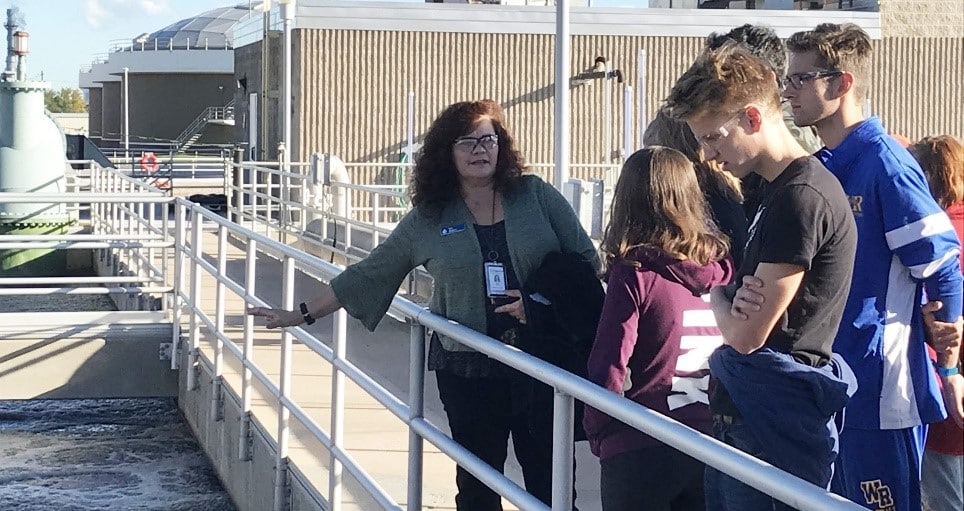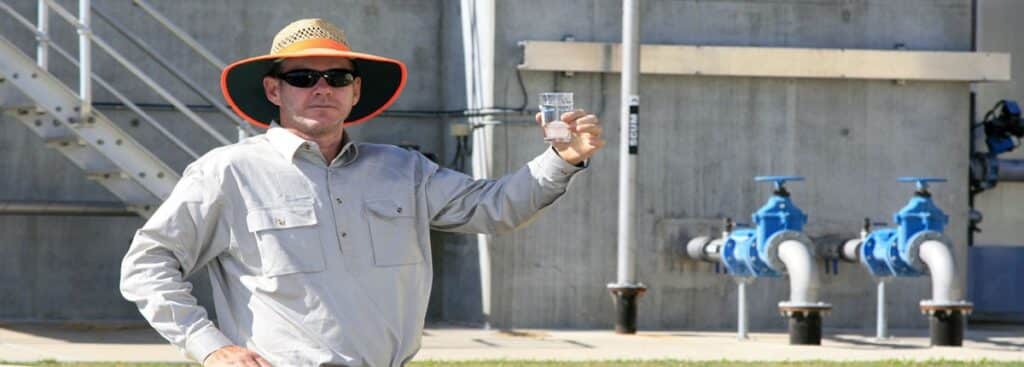Dead lawns, timed showers, and low-flush toilets are what most people think of when they hear the words water conservation. Most of the public discourse around saving water places the burden on consumers and their water use habits. However, as severe drought grips most of the western US and drinking water sources everywhere are threatened by pollution, conservation in all parts of the water system, including treatment and distribution, is going to be crucial. Improving drinking water treatment technology is an important step to improving a water system’s efficiency. Not only are advanced water treatment technologies more water efficient than traditional methods, they offer opportunities for both direct or indirect potable reuse. Transitioning wastewater into a drinking water resource through advanced treatment technologies is one of the most promising forms of water conservation.
While there are a number of innovative technologies that make this possible, they often aren’t accessible to small water systems for a variety of reasons. One significant challenge is hiring operators with the required qualifications and training to operate these technologies. There are a few key reasons for this. There are a limited number of operators trained to operate advanced treatment technologies. Additionally, the water industry is an aging workforce. From American Water Works Association (AWWA) estimates, over half of water treatment operators will be eligible to retire in 5–10 years. An added challenge for small communities is difficultly in attracting outside hires because small communities are sometimes seen as less desirable places to live than larger cities.
One potential solution to the looming workforce crisis is fostering the development of a water treatment workforce in your own community. No one has a more vested interest in a community’s access to safe drinking water than the people who live there. Supporting water treatment education in local schools ensures the incoming workforce will have the skills to operate updated water treatment facilities securing a community’s access to drinking water, and personal ties to the community often fosters dedication and a vested interest in doing the job well.
While operator certifications are conducted at the state level, there are many ways to support water treatment education in your local community.
1. Inclusion in environmental science curriculum
Drinking water treatment is an incredibly diverse practice that incorporates physics, chemistry and microbiology (treatment processes) as well as geography and ecology (source water protection). There are numerous ways to incorporate water treatment into science curriculums at all levels of education. At higher levels, including advanced water treatment processes in the curriculum is an important step to creating a prepared workforce. An additional benefit of this approach is that even students who don’t pursue a career in the water sector will gain an understanding of how water systems work and why individual and community conservation practices are important.
Government and non-government entities offer a multitude of resources from lesson plans to online resources to help teachers incorporate water topics in education. A small sampling includes:
- EPA Teacher’s Resource Guide: Environmental Science Curriculum: https://www.epa.gov/students/lesson-plans-teacher-guides-and-online-environmental-resources-educators-water
- US Geological Survey (USGS) Water Science School: www.usgs.gov/special-topics/water-science-school/teachers-resources-water-education
- Water Environment Federation, resources for teachers K-12: https://www.wef.org/resources/for-the-public/k-12-resources/
2. Vocational programs in local high schools and community colleges
Vocational programs for nurses or firefighters are incredibly popular in high schools and community colleges. These programs encourage students to fill these fundamental roles in their communities. Like nursing and firefighting, the hands-on nature of water sector work attracts students who may steer clear of traditional academics. Water treatment operators are equally as crucial to communities and the profession offers a stable career path that is open to many students. Adapting existing vocational programs to focus on or include water sector jobs will increase awareness of the opportunities and encourage participation. And, students who choose another career path can continue to use their knowledge to be ambassadors for water quality sustainability and conservation in the community. Some resources for incorporating water sector training into education programs are included in the other items in this list.
3. Internship opportunities for high school and college students
Internships for a variety of education levels can help encourage interest in careers in water treatment. Partnering with local high schools and colleges to offer opportunities is an important tool for resource development.
Water First developed an internship program to train drinking water operators in indigenous communities. The program provides young adults with both technical skills and personal development. Find more information at: https://waterfirst.ngo/what-we-do/drinking-water/water-first-internship-program/

Students on a field trip provided by South Platte Renew Wastewater Treatment Plant in Englewood, Colorado.
4. Field trips to local water treatment plants and in-class presentations
Offering tours of local water treatment plants is an important step in fostering interest in water treatment for students of all ages. Seeing people from their community operate treatment processes helps students make the connection between the water that comes out of their tap and all the work that goes into making it safe to drink.
Some examples of field trip programs and resources for in-class presentations are:
- Inland Empire Utilities Agency, Water Discovery Field Trip Program: https://18x37n2ovtbb3434n48jhbs1-wpengine.netdna-ssl.com/wp-content/uploads/2016/10/Water-Discovery-Field-Trip-Activity-Guide-031417.pdf
- South Platte Renew, Resources for teachers: https://southplatterenewco.gov/educators/resources-for-teachers/
While advanced water treatment isn’t often discussed as a water conservation tool, innovative treatment technologies are a fundamental part of an integrated water conservation and sustainability program. These technologies require a skilled workforce to operate and maintain the systems, so workforce development and education is essential for implementing multi-faceted water conservation efforts to address immediate crises and future needs. For small communities, investing in a home-grown workforce through education and training may be the best option.

